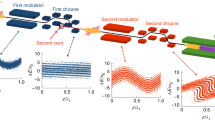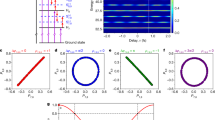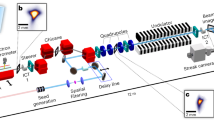Abstract
Free-electron lasers have been successfully operated with ultrahigh brightness and excellent transverse coherence at X-ray wavelengths1,2,3,4. One of the next goals for further improvements is full coherence5,6. An obvious approach is to seed the free-electron laser interaction using a conventional source that has good temporal coherence7,8,9,10,11,12. Here, we show the first lasing of a free-electron laser with an echo-enabled harmonic generation scheme11, which shows great promise for producing coherent lasing at short wavelengths, even in the X-ray regime. The experiment was conducted at a test facility13,14 that combines a 135.4 MeV electron accelerator with an amplifier consisting of a series of undulator magnets. Lasing was achieved at the third harmonic of the seed with a gain of ∼100,000 over spontaneous radiation. The measurements show typical exponential growth and excellent spectral characteristics, as well as good intensity stability.
This is a preview of subscription content, access via your institution
Access options
Subscribe to this journal
Receive 12 print issues and online access
$209.00 per year
only $17.42 per issue
Buy this article
- Purchase on Springer Link
- Instant access to full article PDF
Prices may be subject to local taxes which are calculated during checkout





Similar content being viewed by others
References
Ackermann, W. et al. Operation of a free-electron laser from the extreme ultraviolet to the water window. Nature Photon. 1, 336–342 (2007).
Emma, P. et al. First lasing and operation of an angstrom-wavelength free electron laser. Nature Photon. 4, 641–647 (2010).
Pile, D. First light from SACLA. Nature Photon. 5, 456–457 (2011).
Allaria, E. et al. The FERMI@Elettra free-electron-laser source for coherent X-ray physics: photon properties, beam transport system and applications. New J. Phys. 12, 075002 (2010).
Zeitoun, P., Fajardo, M. & Lambert G. Coherent and compact. Nature Photon. 4, 739–740 (2010).
McNeil, B. W. J. & Thompson, N. R. X-ray free electron lasers. Nature Photon. 4, 814–821 (2010).
Yu, L.-H. Generation of intense UV radiation by sub-harmonically seeded single-pass free-electron lasers. Phys. Rev. A 44, 5178–5193 (1991).
Yu, L.-H. et al. High-gain harmonic-generation free-electron laser. Science 289, 932–934 (2000).
Yu, L.-H. et al. First ultraviolet high-gain harmonic-generation free-electron laser. Phys. Rev. Lett. 91, 074801 (2003).
Lambert, G. et al. Injection of harmonics generated in gas in a free-electron laser providing intense and coherent extreme-ultraviolet light. Nature Phys. 4, 296–300 (2008).
Stupakov, G. Using the beam-echo effect for generation of short-wavelength radiation. Phys. Rev. Lett. 102, 074801 (2009).
Togashi, T. et al. Extreme ultraviolet free electron laser seeded with high-order harmonic of Ti:sapphire laser. Opt. Express 19, 317–324 (2011).
Chen J. H. et al. Operating the SDUV-FEL with the echo-enabled harmonic generation scheme. Chinese Phys. C 33, 706–710 (2009).
Zhao, Z. T. & Wang, D. Progress in the SDUV-FEL and development of X-ray FELs in Shanghai. Proceedings of the 2010 Free-Electron Laser Conference, 23–28 August 2010, Malmo, Sweden, 15–19 (JACoW, 2010).
Young, L. et al. Femtosecond electronic response of atoms to ultra-intense X-rays. Nature 466, 56–61 (2010).
Chapman, H. et al. Femtosecond X-ray protein nanocrystallography. Nature 470, 73–77 (2011).
Seibert, M. M. et al. Single mimivirus particles intercepted and imaged with an X-ray laser. Nature 470, 78–81 (2011).
Kondratenko, A. & Saldin, E. Generation of coherent radiation by a relativistic electron beam in an undulator. Part. Accel. 10, 207–216 (1980).
Bonifacio, R., Pellegrini, C. & Narducci, L. M. Collective instabilities and high-gain regime free electron laser. Opt. Commun. 50, 373–378 (1984).
Feldhaus, J. et al. Possible application of X-ray optical elements for reducing the spectral bandwidth of an X-ray SASE FEL. Opt. Commun. 140, 341–352 (1997).
Ding, Y., Huang, Z. & Ruth, R. D. Two-bunch self-seeding for narrow-bandwidth hard X-ray free-electron lasers. Phys. Rev. ST Accel. Beams 13, 060703 (2011).
Geloni, G. et al. Self-seeding schemes for the European XFEL. Proc. SPIE 8078, 80780R (2011).
Xiang, D. et al. Demonstration of the echo-enabled harmonic generation technique for short-wavelength seeded free electron lasers. Phys. Rev. Lett. 105, 114801 (2010).
Feng, C. et al. Measurement of the average local energy spread of electron beam via coherent harmonic generation. Phys. Rev. ST Accel. Beams 14, 090701 (2011).
Shaftan, T. & Yu L.-H. High-gain harmonic generation free-electron laser with variable wavelength. Phys. Rev. E 71, 046501 (2005).
Huang, Z. R. et al. Effect of energy chirp on echo-enabled harmonic generation free electron lasers, Proceedings of the 2009 Free-Electron Laser Conference, 23–28 August 2009, Liverpool, 221–224 (JACoW, 2009).
Reiche, S. GENESIS 1.3: a fully 3D time-dependent FEL simulation code. Nucl. Instrum. Methods A 429, 243–248 (1999).
Acknowledgements
The authors thank the operation staff in the Shanghai Institute of Applied Physics for excellent support during the SDUV-FEL experiments, as well as the many people at NSRL Hefei, the Accelerator Laboratory of THU, and IHEP Beijing for their help and support. Thanks also go to L.H. Yu, Z. Huang, G. Stupakov and A.W. Chao for useful discussions and their continuous encouragement. The authors acknowledge support from the Chinese Academy of Sciences (grant no. KJCX2-YW-N2), the Ministry of Science and Technology of China (grant no. 2011CB808300) and the National Natural Science Foundation of China (grants nos 10935011 and 11075199).
Author information
Authors and Affiliations
Contributions
Z.T.Z., D.W., J.H.C., C.F. and B.L. co-wrote the paper. All authors designed, constructed and tested the accelerator systems and performed experiments. Z.T.Z. is the SDUV-FEL project director.
Corresponding author
Ethics declarations
Competing interests
The authors declare no competing financial interests.
Rights and permissions
About this article
Cite this article
Zhao, Z., Wang, D., Chen, J. et al. First lasing of an echo-enabled harmonic generation free-electron laser. Nature Photon 6, 360–363 (2012). https://doi.org/10.1038/nphoton.2012.105
Received:
Accepted:
Published:
Issue Date:
DOI: https://doi.org/10.1038/nphoton.2012.105
This article is cited by
-
Generation of ultrahigh-brightness pre-bunched beams from a plasma cathode for X-ray free-electron lasers
Nature Communications (2022)
-
Slippage boosted spectral cleaning in a seeded free-electron laser
Scientific Reports (2019)
-
Towards coherent X-ray free-electron lasers
Nature Photonics (2019)
-
Analysis of electro-optical intensity modulator for bunch arrival-time monitor at SXFEL
Nuclear Science and Techniques (2019)
-
Coherent soft X-ray pulses from an echo-enabled harmonic generation free-electron laser
Nature Photonics (2019)



